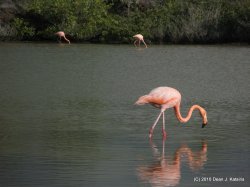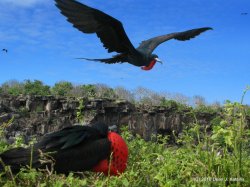Galapagos for the Birds
Tuesday, April 13, 2010
After a bit of a wait at the airport with Freddy (our travel agent here in the Galapagos), our guide, Albarro, took us, the Israelis (Erez and Shiri), a French woman (Delphine) and her parents out to the boat. There was not much going on aboard but eventually the current boat passengers – two Poles and an old Swedish couple were top deck. I won’t say we met them, but they nodded to acknowledge that we were on their boat. I had wrongly assumed that there would be introductions later but that never happened. Albarro came to give us the rundown on how the ship worked and then handed out our rooms. Ours was Room 6 or the Galapagos Shark room, and as it happened just after we put our stuff downstairs there were two Galapagos sharks circling the boat. The rooms were really a level above what I was expecting, with hot water and air conditioning that functioned, if anything, too well. It was soon time for lunch and that too exceeded my admittedly modest expectations by quite a bit: there were no rice and beans to be found! Instead, fish filets in a parmesan and tomato melt with steamed veggies and rice. We had to refill the boat’s fresh water reserves before setting out, which took a lot of time, but then we motored over to Bachas beach on the northwest side of Santa Cruz Island and I guess that qualifies as our first stop on this tour.
 This was a ‘wet landing’ which basically meant that we hopped in the two dinghys and had to hop into the water. Bachas beach was right out of a postcard except without a palm tree to be seen: white sand, various shades of blue waters, black rocks, and life everywhere. While we waited for the dinghy to bring the rest of the passengers I spent some time photographing the numerous crabs watching the surf from the rocks. Then we all set out a short distance to a brackish lagoon with three flamingos in it. I have to admit, I had no idea they could fly; I thought they were like chickens, but we saw one take off and its long neck and wings spread made an awesome silhouette against the sun. I also learned that they feed with their heads upside down to scoop water in their upper beak, and then the water filters out and the small micro-organisms (like shrimp) stay in. After some flamingo watching, we went back to the beach, strapped on our fins, and headed snorkelling in the water. The visibility wasn’t great with all that white sand being stirred up, but Delphine saw a turtle and a few of us saw a baby Galapagos shark, not to mention huge schools of yellow-finned sergeant fish, parrot fish, and the other usual suspects. After a bit more lazing around, it was time to head back to the boat for dinner, which was even more excellent in spite of the fact that the Swedish man attended in his underwear (really), and then had a bit of relaxation before we headed out into the high seas for Genovesa Island on the other side of the equator that night.
This was a ‘wet landing’ which basically meant that we hopped in the two dinghys and had to hop into the water. Bachas beach was right out of a postcard except without a palm tree to be seen: white sand, various shades of blue waters, black rocks, and life everywhere. While we waited for the dinghy to bring the rest of the passengers I spent some time photographing the numerous crabs watching the surf from the rocks. Then we all set out a short distance to a brackish lagoon with three flamingos in it. I have to admit, I had no idea they could fly; I thought they were like chickens, but we saw one take off and its long neck and wings spread made an awesome silhouette against the sun. I also learned that they feed with their heads upside down to scoop water in their upper beak, and then the water filters out and the small micro-organisms (like shrimp) stay in. After some flamingo watching, we went back to the beach, strapped on our fins, and headed snorkelling in the water. The visibility wasn’t great with all that white sand being stirred up, but Delphine saw a turtle and a few of us saw a baby Galapagos shark, not to mention huge schools of yellow-finned sergeant fish, parrot fish, and the other usual suspects. After a bit more lazing around, it was time to head back to the boat for dinner, which was even more excellent in spite of the fact that the Swedish man attended in his underwear (really), and then had a bit of relaxation before we headed out into the high seas for Genovesa Island on the other side of the equator that night.
 When we woke up in the morning, we were in Darwin Bay, a crescent moon of black cliff face crowned plunging down into the green waters. Breakfast was served and we divided into two groups to fit onto the two dinghies. Unfortunately, I wound up on the second dinghy which was the one without a guide and our pilot didn’t feel especially up to guiding the boat alongside the other. So basically it was a ride in silence though occasionally we would hear Albarro saying something like “can grow to be...” as their boat would pass ours. It was pretty frustrating but he said we’d get the tour on the way back even if I knew that were there a tour it would be abbreviated. All those concerns melted away pretty quickly as we climbed Prince Philip’s steps and came face to face with more birds than I have ever seen anywhere – including Alfred Hitchcock films. Albarro proved again to be a knowledgeable guide and went into a lot of details about what we were seeing: frigate birds, red-footed boobies, stormy petrels, and even an endemic owl. The frigate birds were the favourite by far; the males have an inflatable red chest and perch themselves somewhere solid so that when a female flies by they stretch their wings, lean back, and make a woobling sound to call the ladies down. The male red-footed boobies on the other hand, whistle at the females similar to methods employed by humans near construction sites. We got to observe both types of birds doing their courtship rituals, building nests, fighting for twigs, and feeding their young.
When we woke up in the morning, we were in Darwin Bay, a crescent moon of black cliff face crowned plunging down into the green waters. Breakfast was served and we divided into two groups to fit onto the two dinghies. Unfortunately, I wound up on the second dinghy which was the one without a guide and our pilot didn’t feel especially up to guiding the boat alongside the other. So basically it was a ride in silence though occasionally we would hear Albarro saying something like “can grow to be...” as their boat would pass ours. It was pretty frustrating but he said we’d get the tour on the way back even if I knew that were there a tour it would be abbreviated. All those concerns melted away pretty quickly as we climbed Prince Philip’s steps and came face to face with more birds than I have ever seen anywhere – including Alfred Hitchcock films. Albarro proved again to be a knowledgeable guide and went into a lot of details about what we were seeing: frigate birds, red-footed boobies, stormy petrels, and even an endemic owl. The frigate birds were the favourite by far; the males have an inflatable red chest and perch themselves somewhere solid so that when a female flies by they stretch their wings, lean back, and make a woobling sound to call the ladies down. The male red-footed boobies on the other hand, whistle at the females similar to methods employed by humans near construction sites. We got to observe both types of birds doing their courtship rituals, building nests, fighting for twigs, and feeding their young.
 After that walk it was back to the boat to get our snorkel gear and then we snorkelled along the cliffs looking at the schools of sergeant fish and swimming for a time with the furred and regular sea lions. One jumped in the water right behind me which had Bjorn pointing frantically but unlike the sea lions when I snorkelled in Seymour Island, these ones weren’t really interested in anything but relaxing. The afternoon we went to Darwin Beach and took another walk, looking at yet more birds and some snoozing sea lions. Here, the highlight for me was one frigate bird that I found a good position on. I then crouched beside him for probably ten minutes hoping that I could get a female flying by him as he scanned the sky. I was about ready to give up when I snapped the photo you see on the right. The final activity for Genovesa was a snorkel off that beach which was great in spite of the 7m visibility. White-tipped reef sharks, a school of baby angel fish, a puffer fish, two baby spotted eagle rays, a coronet fish, and more. Genovesa was an incredible island to visit and will be a hard act to follow, but tonight we’ll be steaming towards Santiago island to do a tour of the lavascape, swim with Galapagos penguins, and see an entirely different world than today. With no birds.
After that walk it was back to the boat to get our snorkel gear and then we snorkelled along the cliffs looking at the schools of sergeant fish and swimming for a time with the furred and regular sea lions. One jumped in the water right behind me which had Bjorn pointing frantically but unlike the sea lions when I snorkelled in Seymour Island, these ones weren’t really interested in anything but relaxing. The afternoon we went to Darwin Beach and took another walk, looking at yet more birds and some snoozing sea lions. Here, the highlight for me was one frigate bird that I found a good position on. I then crouched beside him for probably ten minutes hoping that I could get a female flying by him as he scanned the sky. I was about ready to give up when I snapped the photo you see on the right. The final activity for Genovesa was a snorkel off that beach which was great in spite of the 7m visibility. White-tipped reef sharks, a school of baby angel fish, a puffer fish, two baby spotted eagle rays, a coronet fish, and more. Genovesa was an incredible island to visit and will be a hard act to follow, but tonight we’ll be steaming towards Santiago island to do a tour of the lavascape, swim with Galapagos penguins, and see an entirely different world than today. With no birds.
Bachas Beach/Genovesa Photos Read More...

No comments:
Post a Comment